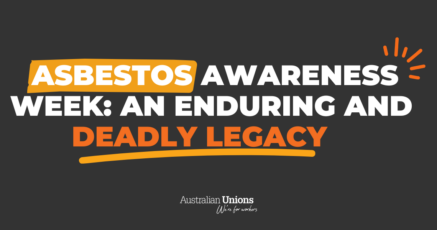You can’t even see the particles that could kill you. Silica dust is so fine that it is 100 times smaller than a grain of sand.
But for hundreds of thousands of Australian workers, the practically invisible dust carries with it a lethal threat.
A new study from Curtin University predicts as many as 10,000 Australians will develop lung cancer in their lifetime due to exposure to silica dust.
Every worker has the right to a safe workplace but more than half a million workers in Australia are currently exposed to the harmful dust.
How exposure occurs
The engineered stone found in artificial stone benchtops contains high levels of silica dust, but the particles can be found in plenty of other construction materials too.
You may be at risk if your job involves bricklaying, demolition work, road construction, stone masonry or manufacturing of glass, ceramics, bricks, concrete or machinery.
Exposure can lead to the development of diseases such as lung cancer, silicosis and kidney disease.
Silicosis is one of the lung diseases that can result from inhaling too much silica. As part of its modelling, the Curtin University study predicts that up to 103,000 workers in Australia will be diagnosed with silicosis.
Although these diseases are often associated with long-term exposure, age is no guarantee of protection. We are seeing young workers dying due to silicosis and these deaths are preventable.
Given the deadly nature of silicosis, it needs to be detected as quickly as possible. But the screening programs don’t reach far enough and still don’t exist in industries like quarrying, mining, construction and tunnelling.
Without these programs, we have no way of knowing how widespread the disease may be.
The campaign to prevent deaths
Members of the Construction Forestry Maritime Mining Energy Union have long been calling for stronger regulation on air monitoring and a ban on dry cutting of engineered products.
Modelling in the Curtin University report shows that if wet cutting methods are used during all concrete cutting and grindings tasks, silica exposure risk would be reduced to a “low level”.
Employers should also be required to provide information to workers as well as job applicants as to whether silica exposure may occur and the measures to limit risk.
To show the real-life impacts of inaction, affected workers in the Australian Workers Union have shared their stories to advocate for better policies and prevent more deaths.
Union members pressuring governments to treat silica dust exposure seriously is how we have stronger protections in states like Victoria.
But while some state governments have set minimum benchmarks to protect workers, these need to be made nation-wide so all workers in every affected industry are protected.
Showing up at work shouldn’t mean putting your life at risk. Workers are people first.
That’s why union members stand together for better workplace conditions and protected workers’ rights.
Cover photo credit: Jana Sabeth on Unsplash








SHARE:
The deadly dust behind your kitchen bench